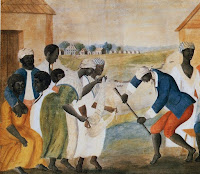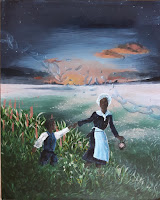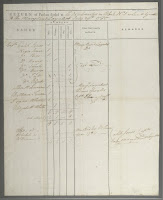What price do you place on the head of another human being? That is the question.
What is my worth?
Am I not a woman and a sister?
My story begins in 1762, when I was born a slave to Caleb Jones. That is where my bondage commenced: on a tobacco plantation near the shores of Chesapeake Bay, Somerset County, Maryland.
 |
| “The Old Plantation”, c. 1785 – 1795; artists (attribution) John Rose; Abby Aldrich Rockefeller Folk Art Museum, NW0159 |
I was brought to this wretched place in 1785 – one of seven slaves Master Jones left here to work his 900 acres of wilderness. The people who have lived here since time immemorial call this place “Nashwaaksis”.
His dream was to establish a vast plantation just like the one he left behind in Maryland.
Loyalist. Ha! He’s no Loyalist. They say he ran away from there, in the cover of dark, with his tail between his legs. Owed too many debts, I hear… and the neighbours did not like him. Made too many enemies. If it weren’t for his wife Elizabeth, he’d be poor as a pauper by now…
 |
| Fredericton Region Museum; Artist: Claire Vautour, 2020 |
Well, back to my story. Soon after I arrived in this place, me and some others, we ran away. I took my son Lidge with me, and we RAN as hard as we could. Where were we running? I’m not sure. We just ran.
It took Jones six days to figure out we were gone; four days later, our names were printed in The Royal Gazette and New Brunswick Advertiser – there on page 3; between the shipping news and property ads:
 |
| Caleb Jones’ Ran away Slaves advertisement (1786), Royal Gazette and the New Brunswick Advertiser, July 25, 1786, UNB Libraries Microform Newspaper Collection |
RAN AWAY – from the subscriber living at the Nashwakshis [sic], in the county of York, between the 15th and 21st days of this instant July, the following bound slaves, viz. ISAAC about 30 years, born on Long island near New York, had on when he went away, a short blue coat, round hat and white trousers. BEN, about 35 years old, had on a Devonshire kersey jacket lined with Scotch plad [sic], corduroy breeches, and round hat. FLORA, a Wench about 27 years old, much pitted with the small-pox, she had on a white cotton jacket and petticoat. Also NANCY about 24 years old, who took with her a child about four years old called LIDGE. The four last mentioned were born in Maryland, and lately brought to this country. All persons are hereby forbid to harbour any of the above, and all masters of vessels are forbid to take any of them onboard their vessel as they shall answer the consequences. A reward of Two Guineas will be paid for each of the men and six dollars for each woman, by Mr Thomas Jennings, if taken and delivered to him at the City of Saint John, at York Point…CALEB JONES, 24th June, 1786.
So that was that. Me and Lidge, we were brought back to Jones, and here we’ve been ever since. For another thirteen long hard years – we worked for that man and his wife…
But then there arrived a little ray of hope.
 |
| Court Transcript of Nancy's trial, Fredericton NB, 1800, Ward Chipman, p. 81, UNB Archives & Special Collections, BC MS, Item 181 |
You see, Caleb Jones has a great deal of enemies here in Nashwaaksis. It seems that two abolitionist lawyers, across the river in Fredericton, took up my cause. Ward Chipman and Samuel Denny Street are their names. Both are good lawyers I’m told. Ward Chipman, he’s a Harvard graduate: “A volunteer for the right of human nature” so he says; Samuel Denny Street, he’s a self-professed Abolitionist: “a regular game-cock… one who will brook no slight from any man”. They accepted my case pro bono! (since I have not a farthing to my name).
So it came to pass, that on July 17, 1799, I was summoned here to court.
Old Jones was ordered to bring me here; and he was none to happy about it either - I’ll tell you that!
 |
| Fredericton Region Museum; Artist: Claire Vautour, 2020 |
The old fool stated his case boldly: “His property” – meaning me (as if I was a piece of furniture, or cattle, or something) – had begun life as a “slave for life”, and so I would remain.
During my trial Ward Chipman skillfully pointed out that New Brunswick has never actually legalised slavery in this colony – and the laws of England do not recognise the rebel laws of Maryland. “Property” be damned… the war with the American colonies put an end to all of that – don’t you think?
The problem here is that too many Loyalists brought their ways from the southern colonies with them. They speak of “the most gentleman-like government on earth” – but there are limits to their gentleman ways, I’ll tell you that.
 |
| Return of people settled between the Nashwaak and Madam Keyswick, 29 July 1785, Winslow Family Papers, UNB Archives & Special Collections, MG H 2, Vol 4, no. 104 |
So now I wait. My fate rests with the court. “Lend a while thine ear to me… set this noble mother free”.
In the end, no judgement was returned on Nancy’s case because the court became divided. Chief Justice Ludlow and Judge Upham ruled in support of Caleb Jones; while Judge Isaac Allen and Judge Saunders ruled against. With no decision being reached, Nancy was returned to her owner, and her case was relegated to a modest account buried within the same provincial newspaper that had reported her run-away notice fourteen years before. She thus disappeared from the written record.
Although Nancy did not gain her freedom, her trial served as a catalyst in the fight against slavery in this province. Her trial also led to freedom for others, since one of the judges who ruled in Nancy’s favour was Isaac Allen. Like Caleb Jones, Judge Allen also depended upon slaves to operate his 2,000-acre estate on the outskirts of Fredericton, at Springhill. Following Nancy’s trial, Judge Allen acted upon his conscious and granted freedom to his own slaves.
Although slavery became illegal in New Brunswick on August 1,1834, the binds of racial injustice continue in Canada to this day.
Although Nancy did not gain her freedom that day, she nevertheless secured a place in Canada’s history for her courage and confidence to speak up - stand up - and bring about change.
Read on about The Blacks of Maugerville...
